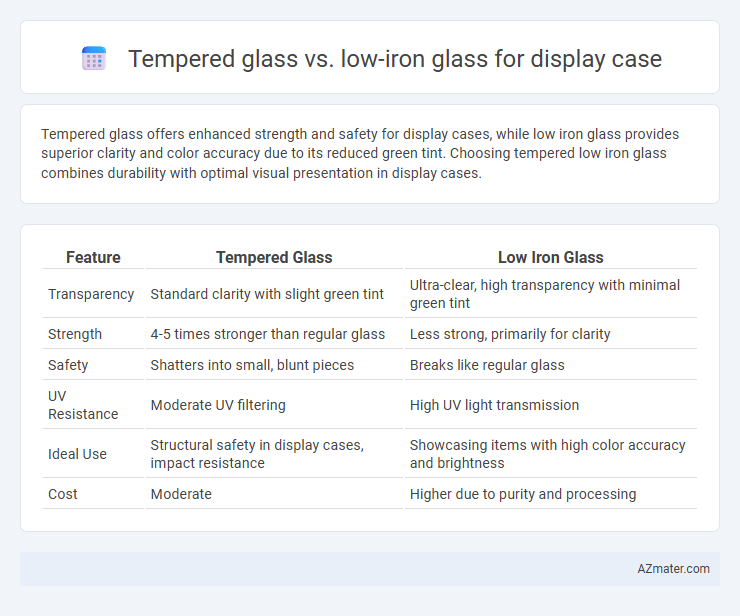Tempered glass offers enhanced strength and safety for display cases, while low iron glass provides superior clarity and color accuracy due to its reduced green tint. Choosing tempered low iron glass combines durability with optimal visual presentation in display cases.
Table of Comparison
| Feature | Tempered Glass | Low Iron Glass |
|---|---|---|
| Transparency | Standard clarity with slight green tint | Ultra-clear, high transparency with minimal green tint |
| Strength | 4-5 times stronger than regular glass | Less strong, primarily for clarity |
| Safety | Shatters into small, blunt pieces | Breaks like regular glass |
| UV Resistance | Moderate UV filtering | High UV light transmission |
| Ideal Use | Structural safety in display cases, impact resistance | Showcasing items with high color accuracy and brightness |
| Cost | Moderate | Higher due to purity and processing |
Introduction to Display Case Glass Options
Tempered glass offers enhanced strength and safety for display cases, making it ideal for high-traffic areas where durability is essential. Low iron glass provides superior clarity and true color representation, improving the visual appeal of displayed items. Choosing between tempered and low iron glass depends on balancing impact resistance with optical quality to best suit the display environment.
What is Tempered Glass?
Tempered glass is a type of safety glass that has been heat-treated to increase its strength compared to regular glass, making it highly resistant to impact and thermal stress. In display cases, tempered glass enhances durability and safety by shattering into small, blunt pieces instead of sharp shards when broken. Low iron glass offers superior clarity due to its reduced green tint, but tempered glass remains the preferred choice for protective applications requiring toughness and safety compliance.
What is Low Iron Glass?
Low iron glass is a specialized type of glass with reduced iron content, resulting in higher clarity and a more transparent appearance compared to standard glass. This clarity enhances the visual presentation of items in display cases by minimizing the greenish tint typically seen in regular glass. While tempered glass offers superior strength and safety, low iron glass is primarily chosen for its aesthetic benefits in showcasing products with true color and brilliance.
Visual Clarity: Tempered vs Low Iron Glass
Low iron glass offers superior visual clarity for display cases due to its reduced green tint, enhancing the true color representation of showcased items. Tempered glass, while stronger and safer, typically contains more iron, which can slightly distort color accuracy and reduce transparency. Choosing low iron glass prioritizes aesthetics and clear viewer experience, whereas tempered glass emphasizes durability and safety.
Strength and Durability Comparison
Tempered glass offers superior strength compared to low iron glass due to its heat-treated process, making it highly resistant to impact and thermal stress, which is crucial for display cases in high-traffic environments. Low iron glass, known for its clarity and minimal green tint, sacrifices some strength but provides enhanced visibility and aesthetics. In terms of durability, tempered glass is more resistant to scratches and breakage, ensuring long-lasting protection for valuable display items.
Safety Features in Display Cases
Tempered glass offers superior safety features for display cases by shattering into small, blunt pieces upon impact, reducing the risk of injury. Low iron glass enhances visibility with higher clarity and minimal green tint but does not inherently improve safety compared to tempered glass. Combining tempered glass with low iron properties provides both enhanced safety and optimal visual presentation in display cases.
Light Transmission and Color Accuracy
Low iron glass offers superior light transmission, typically around 91-92%, compared to tempered glass that transmits about 85-89%, enhancing the visibility of displayed items. The reduced iron content in low iron glass minimizes the greenish tint found in standard tempered glass, resulting in more accurate color representation and true-to-life displays. Choosing low iron glass for display cases ensures optimal clarity and color fidelity, crucial for showcasing high-value or color-sensitive artifacts.
Cost Differences: Tempered vs Low Iron Glass
Tempered glass is generally more affordable than low iron glass due to its standard composition and widespread manufacturing processes, making it a budget-friendly choice for display cases. Low iron glass, with its higher purity and enhanced clarity, commands a premium price driven by additional refining and production techniques. Choosing tempered glass minimizes initial costs, while low iron glass investment offers superior visual appeal at a higher cost.
Best Applications for Each Glass Type
Tempered glass excels in display cases requiring enhanced safety and durability, such as in high-traffic retail environments or museums where impact resistance is critical. Low iron glass offers superior clarity and true color presentation, making it ideal for showcases displaying artwork, collectibles, or luxury items where visual aesthetics are paramount. Selecting tempered glass ensures protection against breakage, while low iron glass maximizes visibility and light transmission for an optimal viewing experience.
Which Glass is Better for Your Display Case?
Tempered glass offers superior strength and safety by being heat-treated to resist impact and shattering, making it an excellent choice for display cases in high-traffic areas. Low iron glass provides exceptional clarity and color accuracy due to its reduced green tint, ideal for showcasing high-end items where visual appeal is critical. For display cases requiring both durability and pristine presentation, tempered low iron glass combines these benefits, offering enhanced protection without compromising visibility.

Infographic: Tempered glass vs Low iron glass for Display case
 azmater.com
azmater.com